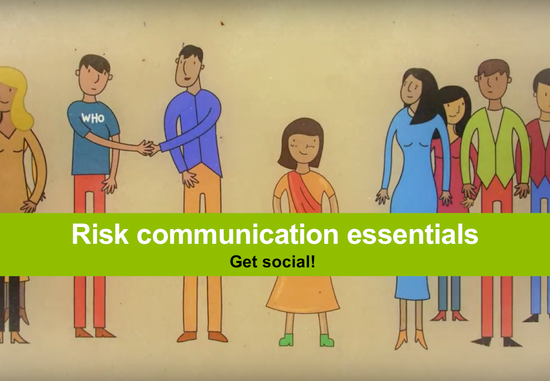
Risk communication is a core public health intervention in any disease outbreak and health emergency. It refers to the real-time exchange of information, advice and opinions between experts, officials and people who face a threat to their wellbeing, to enable informed decision-making and to adopt protective behaviors.
Language: English
English
Health topic
Course information
This course is also available in the following language: français - 中文 - العربية
Overview: Welcome to the online course on risk communication, a core public health intervention in any disease outbreak and health emergency. Risk communication refers to the real-time exchange of information, advice and opinions between experts, officials and people who face a threat to their wellbeing, to enable informed decision-making and to adopt protective behaviors. In this set of 5 modules, we will look at: what is risk communication and why it is important; key elements of risk communication; risk communication capacities, such as policy, strategies and evaluation; SOCO, spokesperson tips and message development; and exercises and ways they can be used to test preparedness in communicating risks. Whether you work for the government, the United Nations, an international organization or an NGO, or you are a volunteer, we hope that this course will help you refresh what you already know and help you transform good principles of risk communication into action. We hope that you will be encouraged to look at resources that are attached to each module to dwell further into this topic, to find tools and resources that will help you in your work.
Learning objective: By the end of this course, participants should be able to understand the core principles of risk communication and its application to disease outbreaks and health emergencies.
Course duration: This course consists of an introductory video lecture, presentation slides that can be downloaded and reviewed at your own pace, and instructions for simulation exercises. Course duration may vary. It will take most participants approximately 8 hours to thoroughly complete all components.
Certificates: No certificate available at this time.
Course contents
Module A: Course Introduction:
By the end of this module, you should be able to describe what this course is about, and also: define risk communication; identify its foundational building blocks; and discuss guiding principles for best practices.Module B: Risk Communication 101:
By the end of this module, you should be able to: define risk communication; identify its foundational building blocks; and discuss guiding principles for best practices.Module C: Risk Communication Capacities:
By the end of this module, you should be able to: describe why it is important to have a systematic approach to ERC capacity; list the critical considerations for developing a systematic approach to ERC capacity building at the national and local levels; and describe building blocks required for developing ERC capacity.Module D: Tools:
By the end of this module, you should be able to: describe why it is important to look at communication outcomes when setting objectives; describe the components of a Single Overarching Communication Outcome (SOCO); and list building blocks for stakeholder/audience analysis.Module E: Exercises:
By the end of this module, you should be able to: describe the importance of conducting an exercise; describe the different kinds of exercises used for testing preparedness of the communication response; and list the benefits of exercises for testing the preparedness for an emergency.Module A: Course Introduction (English and Portuguese):
By the end of this module, you should be able to describe what this course is about, and also: define risk communication; identify its foundational building blocks; and discuss guiding principles for best practices. Disclaimer: These presentation slides are a draft version and are not yet verified translations. These slides are for field use only.Module B (English and Portuguese):
By the end of this module, you should be able to: define risk communication; identify its foundational building blocks; and discuss guiding principles for best practices. Disclaimer: These presentation slides are a draft version and are not yet verified translations. These slides are for field use only.Module C (English and Portuguese):
By the end of this module, you should be able to: describe why it is important to have a systematic approach to ERC capacity; list the critical considerations for developing a systematic approach to ERC capacity building at the national and local levels; and describe building blocks required for developing ERC capacity. Disclaimer: These presentation slides are a draft version and are not yet verified translations. These slides are for field use only.Module D (English and Portuguese):
By the end of this module, you should be able to: describe why it is important to look at communication outcomes when setting objectives; describe the components of a Single Overarching Communication Outcome (SOCO); and list building blocks for stakeholder/audience analysis. Disclaimer: These presentation slides are a draft version and are not yet verified translations. These slides are for field use only.Module E (Portuguese):
By the end of this module, you should be able to: describe the importance of conducting an exercise; describe the different kinds of exercises used for testing preparedness of the communication response; and list the benefits of exercises for testing the preparedness for an emergency.